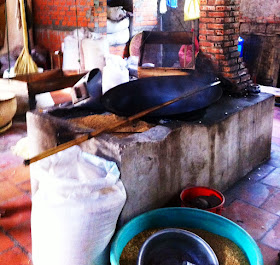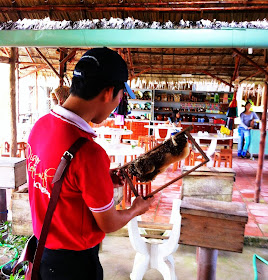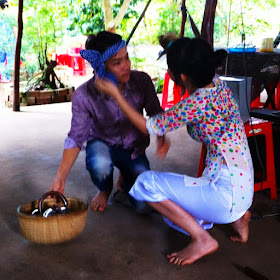The Mekong Delta in southern Vietnam is one of the world's richest agricultural regions, and according to our tour guide, just surpassed Thailand as the number one exporter of rice. The climate, fertile soil, river waters, and centuries old cultivation techniques gives the Mekong a distinct advantage by being able to harvest rice 3 times a year. Besides rice, there's a large commercial fishing industry and many tropical fruits grow in this fertile land. Well, that sure sounded like a fifth grader encyclopedia report on the Mekong Delta (do they even do that in school anymore? What's an encyclopedia? Ha, ha).
 |
| Breakfast, pho ga, on our way to the Mekong delta. |
Fortunately, the tour that our hotel arranged for us through TNK Travel was good, which was a huge relief because there are many, many (did we mention many?) tour operators from Ho Chi Minh City with plenty of horror stories that rival in number. We didn't find any websites that provide a pooling of reliable information on the tour operators, including Lonely Planet and TripAdvisor, so we were shooting from the hip. The one day tour that was suppose to include the Cai Be floating market also included many activities and demonstrations showcasing a cultural sampling of Mekong life (put on display for tourists, of course). We had a sudden flashback to the Polynesian Cultural Center and Luau in Hawaii!
After a 2.5 hour drive to the northern-most part of the Mekong Delta, we boarded a motorized long boat and cruised through the Cai Be floating market. As expected for a one day tour, the floating market was virtually over when we got there at 9:30 am, so we didn't get to see much of the iconic selling and buying of produce, floating food stalls and coffee shops, that we wanted to see. All this activity occurs from 6 am to about 8 am, so yet another reason to spend more than one day in the delta! We did see some commerce on the river, and a lot of house boats so that was very interesting.
Other activities included visiting a place that makes popped rice candy (Vietnamese rice Krispy treats!); coconut candy making demonstration; watching how they make the super-thin rice paper wrapper; sampling some snake-infused Mekong rice wine; playing with a python; drinking raw honey tea (mixed with lime juice, mint, and hot water); a ride through the narrow canals; traditional Vietnamese song performances; and a walk through a traditional Vietnamese folkhouse preserved from 1838. Exhausted yet? Yes, it was a busy day.
- Video, making popped rice. Similar to kettle corn!
- Video, making rice paper wrappers.
- Videos, Mekong River 1, Mekong River 2.
MEKONG RIVER AND CAI BE FLOATING MARKET
RICE KRISPIE TREATS, VIETNAMESE STYLE
COCONUT CANDY MAKING OPERATION
A LITTLE RICE WINE TASTING
RICE PAPER, HONEY BEES, AND PYTHONS
CRUISING THROUGH THE CANALS
TRADITIONAL VIETNAMESE MUSIC PERFORMANCE
TROPICAL FRUITS
TRADITIONAL VIETNAMESE FOLKHOUSE, 1838
LUNCH
We completed the tour with a late lunch of fried Mekong river fish as an appetizer wrapped in rice paper with pineapple, star fruit, and herbs; followed by Mekong prawns; and a clay pot of stewed pork and rice. The setting was very beautiful, surrounded by tropical fruit trees. The only trepidation was not knowing where this fish came from. We hope it was farmed elsewhere and not directly from the Mekong where the river is a dumping ground for everything, not to mention we were "down river" from the other countries who also have access to the Mekong River: China, Myanmar, Laos, Thailand, and Cambodia. Also, 40 years ago, the area was heavily bombed with Agent Orange to defoliate the landscape, which of course, leeched into the waters. We can imagine any fish that survived has morphed into a species perfect for the TV show, River Monsters.
We enjoyed our touristy day with our funny and talkative tour guide, An. It was better than we expected and a good way to sample Vietnamese life without having to do a lot of work on your own. It's not an authentic experience, but a good primer. Next time, we'll plan on getting lost in the deep south of the delta for at least a week, stay in a hidden stilt house, hire our own boat operator, and do some exploring that way.



























































